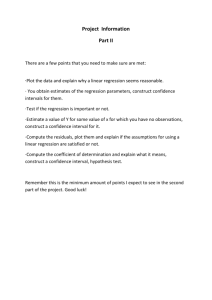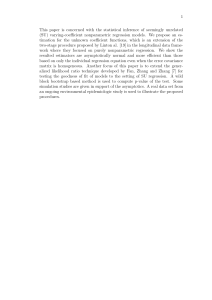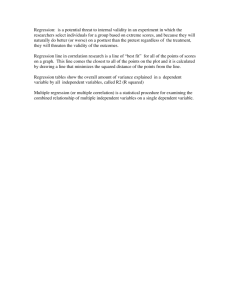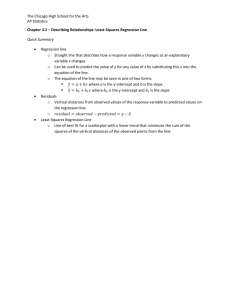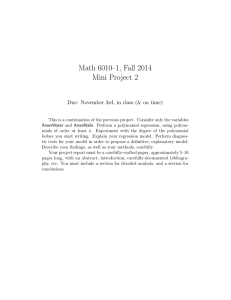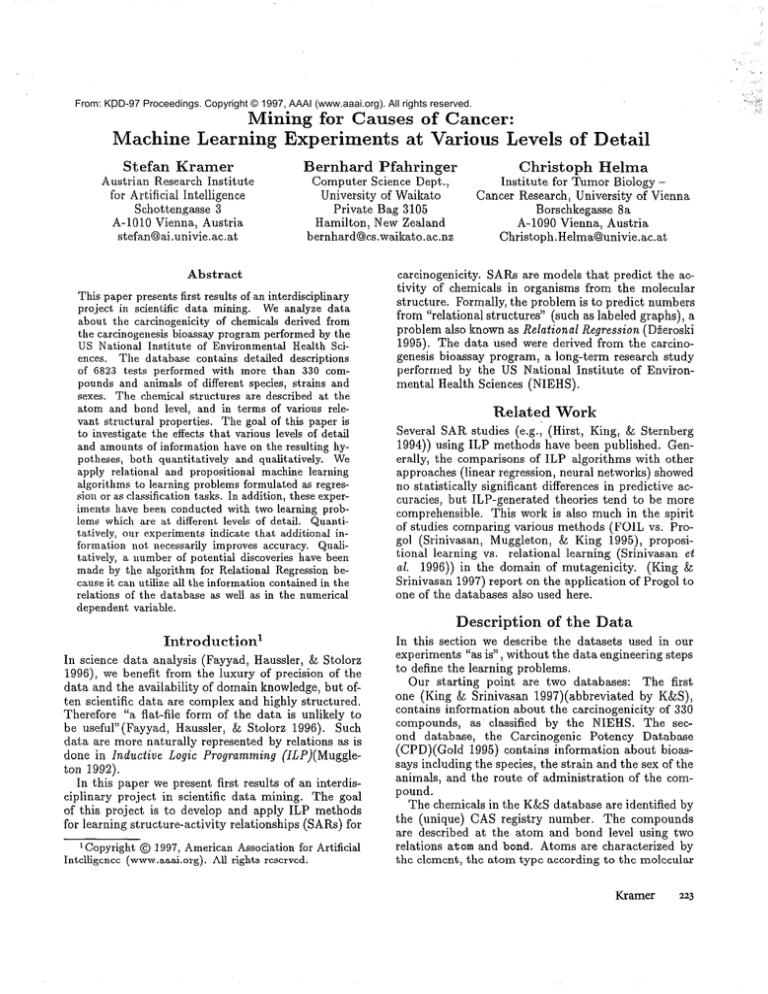
From: KDD-97 Proceedings. Copyright © 1997, AAAI (www.aaai.org). All rights reserved.
Machine
Stefan
Mining for Causes of Cancer:
Learning Experiments
at Various Levels
Kramer
Austrian Research Institute
for Artificial Intelligence
Schottengasse 3
A- 10 10 Vienna, Austria
stefan@ai.univie.ac.at
Bernhard
Pfahringer
Computer Science Dept.,
University of Waikato
Private Bag 3105
Hamilton, New Zealand
bernhard@cs.waikato.ac.nz
Abstract
This paper presents first results of an interdisciplinary
project in scientific data mining. We analyze data
about the carcinogenicity of chemicals derived from
the carcinogenesis bioassay program performed by the
US National Institute of Environmental Health Sciences. The database contains detailed descriptions
of 6823 tests performed with more than 330 compounds and animals of different species, strains and
sexes. The chemical structures are described at the
atom and bond level, and in terms of various relevant strnctural properties. The goal of this paper is
to investigate the effects that various levels of detail
and amounts of information have on the resulting hypotheses, both quantitativel? and qualitatively. We
apply relational and propositional machine learning
algorithms to learning problems formulated as regression or as classification tasks. In addition, these experiments have been conducted with two learning problems which are at different levels of detail. Quantitatively, our experiments indicate that additional information nob necessarily improves accuracy. Q&itatively, a number of potential discoveries have been
made by the algorithm for Relational Regression because it can utilize aII the information contained in the
relations of the database as welI as in the numerical
dependent variable.
Christoph
In science data analysis (Fayyad, Haussler, & Stolorz
1996), we benefit from the luxury of precision of the
data and the availability of domain knowledge, but often scientific dat(a are complex and highly structured.
Therefore “a. flat-file form of the data is unlikely to
be useful”(Fayyad, Haussler, & Stolorz 1996). Such
data are more naturally represented by relations as is
done in Inductive Logic Programming (ILP)(Muggle4....b”ll ,nno\
1 JYA).
In this paper we present first results of an interdisciplinary project in scientific data mining. The goal
of this project is to develop and apply ILP methods
for learning structure-activity
relationships (SARS) for
lcopyright @ 1997, American Association for Artificial
Intelligence (www.aaai.org). All rights reserved.
Helma
Institute for Tumor Biology Cancer Research, University of Vienna
Borschkegasse 8a
A-1090 Vienna, Austria
Christoph.Helma@univie.ac.at
carcinogenicity. SARs are models that predict the activity of chemicals in organisms from the molecular
structure. Formally, the problem is to predict numbers
from “relational structures” (such as labeled graphs), a
problem also known as Relational Regression (Dieroski
1995). The data used were derived from the carcinogenesis bioassay program, a long-term research study
performed by the US National Institute of Environmental Health Sciences (NIEHS).
Related
Work
Several SAR studies (e.g., (Hirst, King, & Sternberg
1994)) using ILP methods have been published. Generally, the comparisons of ILP algorithms with other
approaches (linear regression, neural networks) showed
no statistically significant differences in predictive accuracies, but ILP-generated theories tend to be more
comprehensible. This work is also much in the spirit
of studies comparing various methods (FOIL vs. Progo1 (Srinivasan, Muggleton, & King 1995), propositional learning vs. relational learning (Srinivasan et
al. 1996)) in the domain of mutagenicity.
(King &
Srinivasan 1997) report on the application of Progol to
one of the databases also used here.
Description
Introduction1
of Detail
of the Data
In this section we describe the datasets used in our
experiments “as is”, without the data engineering steps
to define the learning problems.
Our starting point are two databases: The first
one (King & Srinivasan 1997)(abbreviated by K&S),
contains information about the carcinogenicity- of 330
compounds, as classified by the NIEHS. The second database, the Carcinogenic Potency Database
(CPD)(Gold 1995) contains information about bioassays including the species, the strain and the sex of the
animals, and the route of administration
of the compound.
The chemicals in the K&S database are identified by
the (unique) CAS registry number. The compounds
are described at the atom and bond level using two
relations atom and bond. Atoms are characterized by
the element, the atom type according to the molecular
Kramer
223
#
#
#
#
examples
t,uples
relations
features
K&S DB
330
21031
41
38
CPD
6823
6823
1
6
Joined DB
6823
27524
42
42
Chem.
Examples
Tests
bependent
variable for
classification
Dependent
variable for
regression
Examples
Table 1: Quantit(ative overview of the databases.
modelling package QUANTA, and the partial charges.
The bonds are defined as relations between atoms, and
also have types (according to QUANTA). Additionally,
the existence of functional groups (such as benzene
rings and methyl groups) and of so-called Ystructural
alerts” is represented. Finally, the outcome of the ames
lest for mutagenicity, which is highly correlated with
carcinogenicity, has been included. The NIEHS has
classified these chemicals as non-carcinogenic, equivocal and carcinogenic.
Gold’s CPD contains detailed descriptions of bioassays performed by the NIEHS and other organizations.
For each bioa.ssay, we know the statistical significance
nf t130
r\ntr*nm~
"1
"J.l" "U"Y",l‘
"
\'IPT/nl\
I W",
lrlrl
t.13l3
YALU
"*Au tnmrrriamir
"UAAL'""b"l"U
rlnae
UVU"
frrr
L"I
50% of the animals (TD50). The unit of the TD50
is rng/kg body weight/day. The efSect of a compound
is described by PVal: if the value indicates statistical
significance, then the compound is carcinogenic. The
activity of a substance is described by TD50. E.g., if
the TD50 is very low for the animals in a group, t,hen
the substance is highly carcinogenic.
As is, t,he CPD does not contain chemical descriphors, but, the chemicals used are identified by the CAS
registry number. So we joined t(he CPD with t#he K&S
dat,abase via. t,he CAS registry number, and obtained
a. d&abase cont,aining information about bioassays as
well as information about, the chemicals used. The
joined DB is t,he basis for further investigations concerning species-specific, st(rain-specific, sex-specific and
route-specific models for carcinogenicity. From a biological point, of view, this is one of the novelties of our
project. Table 1 gives a quantitative overview of the
three databases.
Description
of the Approach
In this se&on we describe our approach to analyzing t,he data.. Our goal is to investigate the effects of
increasing levels of detail in the data, both in the independent, and t,he dependent variables. The dimensions investigated are chemicals vs. tests as examples, classification vs. regression, and propositional
vs. relational learning. To allow for meaningful comparisons, the examples of the learning problems have
to be t,he sa.me, and t(he same measures of accuracy
have to be applied.
Therefore, results for chemicals and tests are not directly comparable. However,
all combinations E { ~Zassification, reyression}
x
{pro~osz’tion.aZ, relational}
are quantitatively comparable for both chemicals and tests, since classification
accuracy can also be calculated for regression models.
224
KDD-97
f1
1
Those with valid TD50
1
only (i.e., only those
with significant outcome,
PVal < 0.05). In case of
conflicting TD50 values:
one example with
Dependent
variable for
classification
Dependent
variable for
reeression
Table 2: Definitions
study.
!
of the learning problems in our
In the following, we will discuss the dimensions investigated in this study. A summary of the definitions of
the learning problems can be found in Table 2.
Chemicals as Examples/Tests
as Examples
For the first, series of experiments, we used the K&S
database with chemicals as examples. In the second
series of experiments, the tests (i.e., individual bioassays) from the joined database were used as examples.
We focused on a few attributes (species, strain, sex
and route of administration),
and on only those tests
with carcinogenic substances (PVuE < 0.05). We defined the dependent variable as the minimum TD50 of
-11
all
,\.rnm,.lnr,+L~+
cxo,rLlplnY
IJllcL"
.Y,.*
o,IG
:,lnnC:nnl
Iu-~IIlJILaI
,T+L.M.T:.,:,,
"VII~l""1D~)
: A
1.G.)
tube
dose
that in at least one case is tumorigenic.
Classification/Regression
For the chemicals, we were learning the NIEHS assessments (non-carcinogenic, equivocal or carcinogenic).
Basically, this dependent variable is ordinal, but it can
also be used for classification. Since we are not aware
of relational learning algorithms dealing with ordinal
dependent variables, we formulated a regression problem by mapping the NIEHS assessment to (-1, 0,l).
The scale does not play a role because we evaluated the
results by the relative error (see e.g. (Quinlan 1992)).
The classification accuracy was calculated in the following way: if a regression rule predicts a negative
value, then we predict “non-carcinogenic”, else we predict LLcarcinogenic”.
For tests as examples, we derived the classification
problem from the regression problem by discretization of the dependent variable. We chose a simple
discretization of the tumorigenic dose (TD50):
if the
value is bigger than the median, then the exarnple be-
Examples
Chemicals
I f-‘hmm;r.~lc
Form.
Prop.
Task
Class.
Algorithm(s)
C4.5, T2
PW,r\
RPlPF
liiF;
Approach
Default
A -PC
, LllllU”
l-act
.L”U”
Propositional
Classification
Table 3: Algorithms applied to the two learning problems and different formulations of them.
longs to class 1, otherwise it belongs to class 0.
Propositional
Learning/Relational
Learning
To obt,ain a propositional version of the learning problems, we utilized the high-level chemical information
from the K&S database, including functional groups,
st,ructural alerts and the result of the ames test. The
ILP setsting includes additional low-level structural details about atoms and bonds.
Algorithms
Used
In Table 3, we present t,he algorithms used for our
comparative study. For propositional classification, we
used C4.5 (Quinlan 1993), and T2 (Auer, Maass, &
TT-IL_._^_I-,c”tx
r) ,--.-, “Gc;,W”I,
A-^:-:-- +blw.zii.
-^^- l7ATT
rI”lLt: ,nnc\
lVVU,, -.,-:-I.
WI,,CIl z-2
,IlULlL;t3
I’“lLl
(Quinlan 1990) and P rogol (Muggleton 1995) are stateof-the-art, ILP algorithms. M5 (Quinlan 1992) learns
regression trees with linear regression models in the
leaves. SRT (Kramer 1996) learns relational regression
trees.
Propositional
Regression
Relational
Classification
Relational
Regression
Algorithm
,,
Accuracy
55.00%
I,
G-2
““.““%nn
Rel. E.
I
-
I
C4.5 prune
C4.5 rules
T2
M5
58.79%
60.76%
65.00%
69.93%
0.98
FOIL
Progol
SRT
25.15%
63.00%
72.46%
0.14
Table 4: Quantitative results for chemicals obtained
by 5-fold cioss-validation.
algorithms.
The bad performance of FOIL may be
due to the multiple classifications which are counted
as misclassifications.
Next we present the major discoveries and findings
from our experiments. One of the authors is an expert
in toxicology, and interprets the theories induced by
the learning algorithms.
The rules found by C4.5 and FOIL are relatively
lengthy, and do not provide many new insights. The
rules reflect mostly what we specified as indicators of
carcinogenicity, namely the ames tests and structural
alerts. (Note that these algorithms also could have
used the functional groups.) Some of the theories are
quite accurate, but they are no real discoveries. An
extreme example is the theory found by the T2 almn4thx.m
.,,h;,h
nrr;ta cbb~uIcIIut‘
nec,.r.atn )
h,.t
o;n,.o 1”
;t
VU” tv;,,;,l
“lIYI.za,
“IIltib
~“I1UII111)
YYIIIbLI ;,‘0 yLucL
contains the ames test, and tests for structural alerts
in the second level.
The theories found by C4.5 and FOIL are relatively
easy to interpret for an expert, because the conditions
in the theories relate to the structure of a compound.
So an expert can easily draw some structures which are
subsumed by a given rule. Besides, none of the rules
found are in contradiction to “toxicological commonsense”.
In contrast to C4.5 and FOIL, SRT often uses partial
charges of atoms in its theories to discriminate the examples. Therefore, it appears possible that the effect
of a chemical depends more on partial charges than on
chemical structure.3 This interesting issue will be a
point of departure for further investigations.
The rules found by C4.5, FOIL and SRT reveal
that certain functional groups (methyl groups, benzene rings, 6 membered ring) are, depending on the
context, in some cases activating and in others deactivating. This pattern is in accordance with present
toxicological knowledge.
Most of the qualitative insights were gained from the
-P atoms
-L-.---1----appiication of SRT. O----.-l
3everaI Itypes- 01
uave L--.ueeu
found to be deactivating: atoms of type 8 according
t,o QUANTA (e.g. “atoms with 2 double bonds on
a 4 membered ring”), atoms of type 14 (e.g. “atoms
with double bonds on a 4 membered ring with 3 double
bonds”), and sulfur atoms.
These observations can be made both in the application to chemicals and in the application to tests.
2Tl~e experiment with Progol has been described in
(King & Srinivasan 1997).
“Note that in some sense partial charges are caused by
the chemical structure.
Experimental
Results
First we discuss the quantitative results of the experirnents (see Table 4 and Table 5). For the chemicab,
we did
in accuracy except
~ not observe big differences
? - ,7
for Relational Regression. bR.1 achieves (with statistical significance) the best accuracy for the chemicals.
Regression seems to perform slightly better than classification. However, the biggest difference was between
using all the information, and using only part of the
information.
Quantit,atively, the results for the tests are in total
cont(rast. to t*he results for the chemicals. Here, the
det,ails providecl do not seem to pay off: propositional
cla.ssification algorithms are quantitatively superior to
t,he rest,. This may be due to the huge differences in
th,
“Ub
TprlKll
1 U”“,
which
YYIlItil,
m.z,~r
P.,,,cP
l,lrvJ
x,auucI
n,.nhlmmc
y”“u’
u”‘Y
fnr
IVI
~~m.r?&nn
‘“6’“““‘“”
Kramer
225
Approach
Default
Propositional
Classification
Propositional
Regression
Relational
Classification
Relational
Regression
Algorithm
C4.5 prune
C4.5
T2
M5
Accuracy
50.00%
67.56%
65.43%
59.86%
56.67%
Rel. E.
1.23
FOIL
31.39%
-
SRT
56.19%
0.77
Table 5: Quantitative
fold cross-validation.
results for tests obtained by 5-
Although these results might be real discoveries, additional ana.lyses by independent domain experts are
required to confirm t,hem.
In general, SRT uses the same properties of compounds in bot(h applications. Applied to tests, SRT
additionally uses species, sex or route near the leaves
of the trees. This way we recognized that mice might
have a much higher TD50 t(han rats, On the average,
the ratio TD50,,,,,/TD50,,~
is 1.599. This confirms
previous findings by Gold and co-workers that rats react more sensitively towards carcinogens than mice.
Qualitatively, we observed that propositional learning algorithrns utilize chemical knowledge only in the
form of key at,tributes. Most of the potential discoveries were obta.ined by an algorithm for Relational Regression which utilizes all t#he available information.
Further
Work
and Conclusion
One of our next steps will be to include the tumorigenic
site (i.e., the target organ) in the description of the
bioassays. Since there will be fewer conflicting TD50
values, rnore examples can be used for learning.
In summary, we investigated the effects that various levels of d&ail and amounts of information have
on t,he resulting hypotheses, both quantitatively and
qualitatively. We applied relational and propositional
machine learning algorithms to learning problems forrnulated as regression or as classification tasks. In addit,ion, these experiments have been conducted with two
learning problems which are at different levels of detail: first with chemicals as examples, second with tests
as examples. Quantitatively, our experiments indicate
that additional information not necessarily improves
accuracy. Qualitatively, a number of potential discoveries have been made by the algorithm for Relational
Regression because it can utilize all the information
contained in the relations of the database as well as in
the numerical dependent variable.
Acknowledgements
This research was sponsored by
the Austrian Foncls zur F&&rung
der Wissenschaftlichen
Forschung (FWF) under grant number P10489-MAT and
under grant number Schr6dingerstipendium
Nr.J01269-
226
KDD-97
MAT. Financial support for the Austrian Research Institute for Artificial Intelligence is provided by the Austrian Federal Ministry of Science and Transport. Bernhard
Pfahringer acknowledges the support of the ML group of
the University of Waikato. We would like to thank R. King,
A. Srinivasan and L. Gold for providing the carcinogenicity
data, and G. Widmer for valuable discussions.
References
Auer, P.; Maass, W.; and Holte, R. 1995. Theory and
applications of agnostic pat-learning with small decision
trees. In Prieditis, A., and Russell, S., eds., Proceedings
Conference on Machine Learning
of the 12th International
(MLSS). Morgan Kaufmann.
Dieroski, S. 1995. Numerical Constraints and Learnability in Inductive
Logic Programming.
Ph.D. Dissertation,
University of Ljubljana, Ljubljana, Slovenija.
Fayyad, U.; Haussler, D.; and Stolorz, P. 1996. KDD for
science data analysis: Issues and examples. In Proceedings
of the Second Taternational Conference on Knowledge Discovery and Date; Mining (KDD-96),
50-56. Menlo Park,
CA: AAAI Press.
CT&_. I T..
199.5.
-. ----.
Sixrt,h
dot.
r---
of
I--..
-- the
carrinnvmicitv
--^----o------“J
nntmrv
r-“----J
in the general literature 1989 to 1990 and by the national
Health
toxicology program 1990 to 1993. Environmental
Perspectives 103 (Supp17):1-122.
Hirst, J.; King, R.; and Sternberg, M.
1994. Quanti-
tative structure-activity
relationships by neural networks
and inductive logic programming. the inhibition of dihydrofola.t,e reductase by pyrimidines. Journal of CnmputerAided Molecular Design 8:405-420.
King, R., and Srinivasan, A. 1997. Prediction of rodent
carcinogenicity bioassays from molecular structure using
inductive logic programming.
Environmental
Health Perspectives.
Kramer,
S. 1996. Structural
regression trees. In ProceedConference on Artijicial
ings o,f the Thirteenth
National
Intelligence (AAA I-96).
.~~~e~leton.
Qo------I
Sai ed:
1992,
mI&uct&
Lo&
--il--
_Prrw7mmm.in.n.
-=. - .._..__._ J.
London, U.K.: Academic Press.
Muggleton, S. 1995. Inverse Entailment and Progol. Nezu
Generation Computing 13:245-286.
Quinlan, J. 1990. Learning logical definitions from relations. Machine Learning 5:239-266.
Quinlan, J. 1992. Learning with continuous classes. In
Adams, S., ed., Proceedings AI’9i?, 343-348.
Singapore:
World Scientific.
1‘1, c. 1D_^I_^
-^ J”’
Jf^&.I”l.IL(;,‘
rl/rP.^LII^
r-m&.-:-,”
C-L.:..,,..
T 1JJ.J.
1nno vy.u.
.&$U’
ILI”‘L,rl.
rvyr 11,163
l,‘(; L/GUI
w6rq.
San Mateo, CA: Morgan Kaufmann.
Srinivasan, A.; Muggleton, S.; King, R.; and Sternberg,
M. 1996. Theories for mutagenicity: a study of first-order
and feature based induction. Artificial
Intelligence
85(12):277-299.
Srinivasan, A.; Muggleton, S.; and King, R. 1995. Comparing the use of background knowledge by Inductive
Logic Programming systems. In Proceedings of the 5th
Workshop on Inductive Logic Programming
International
(ILP-95),
199-230. Katholieke Universiteit Leuven.

